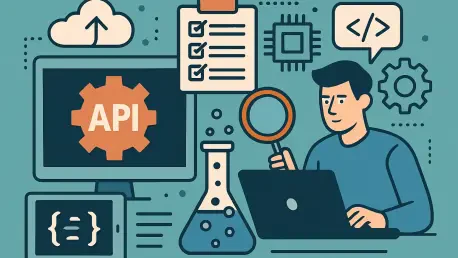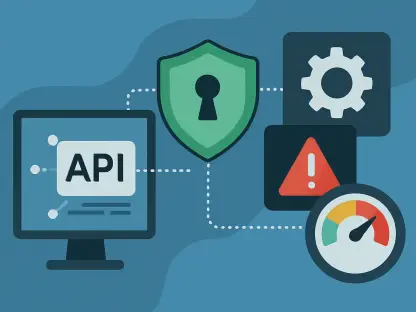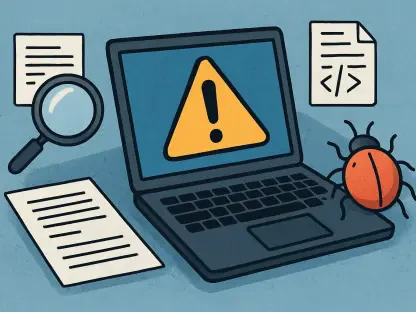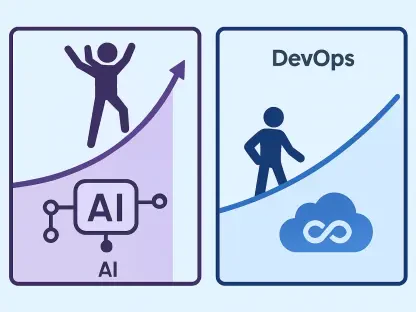In an era where digital ecosystems thrive on seamless connectivity, consider the staggering reality that over 90% of modern applications rely on APIs to function, from facilitating online transactions to powering social media interactions, underscoring a critical challenge. Ensuring these invisible connectors operate flawlessly under diverse conditions is paramount, as APIs, or application programming interfaces, form the backbone of software communication, making their reliability essential to user experience and business success. This review delves into the essentials of API testing, dissecting its methodologies, tools, and evolving trends to illuminate how this practice safeguards the integrity of digital interactions in a hyper-connected world.
Understanding the Core of APIs and Their Significance
APIs serve as vital intermediaries that enable distinct software systems to communicate by adhering to standardized protocols. They act as conduits for requests and responses, ensuring that disparate applications can interact without friction. This functionality is foundational to countless everyday technologies, such as mobile apps fetching real-time data or websites integrating third-party services, highlighting their indispensable role in the digital landscape.
The impact of APIs extends beyond mere connectivity; they drive scalability by allowing systems to expand through modular integrations. Their flexibility empowers developers to innovate rapidly, creating tailored solutions that enhance user engagement. From enabling secure payment gateways to supporting cross-platform content sharing, APIs underpin the smooth experiences users expect in today’s tech-driven environment.
Their significance is further amplified in an interconnected world where businesses rely on integrated systems for efficiency. As the linchpin of modern software architecture, APIs facilitate collaboration across industries, making their robustness a non-negotiable factor. This reality places API testing at the forefront of quality assurance, ensuring these critical components withstand the demands of diverse operational scenarios.
Diving into API Architectures and Protocols
REST – The Cornerstone of Modern API Design
Representational State Transfer, commonly known as REST, stands as a dominant architectural style for crafting APIs that prioritize simplicity and scalability. It leverages standard HTTP methods like GET and POST to manage resources, often using JSON as a lightweight data format for exchanges. This approach ensures that interactions between clients and servers remain stateless, fostering efficient and predictable communication.
REST’s design principles enable developers to build systems that can handle vast numbers of requests without compromising performance. Its widespread adoption in web services stems from the ease of integrating with existing HTTP infrastructure, making it a go-to choice for many modern applications. The clarity of RESTful interactions, supported by status codes and headers, further enhances reliability across diverse platforms.
SOAP – Structured and Secure Data Exchange
Simple Object Access Protocol, or SOAP, offers a highly structured framework for data exchange, primarily through XML-based messaging. It operates under strict guidelines defined by Web Services Description Language (WSDL), ensuring precise communication rules between systems. This protocol’s adaptability to various transport mechanisms, beyond just HTTP, adds to its versatility in complex environments.
Particularly prevalent in sectors like finance and healthcare, SOAP excels where security and transactional integrity are paramount. Its detailed message envelope structure, which encapsulates both data and metadata, provides a robust mechanism for handling sensitive operations. This makes SOAP a preferred option for enterprise-level integrations requiring stringent compliance with regulatory standards.
RPC – Efficient Remote Function Execution
Remote Procedure Call, known as RPC, facilitates direct function execution on remote servers, mimicking local calls while abstracting network complexities. It proves invaluable in microservices and distributed systems where low-latency communication is critical. Protocols like JSON-RPC and gRPC exemplify RPC’s application, enabling swift interactions in scenarios such as remote banking queries or real-time service responses.
This architecture supports streamlined, function-oriented communication, ideal for environments demanding rapid data processing. By focusing on procedural efficiency, RPC aids in building responsive systems that cater to dynamic user needs. Its role in modern software design continues to grow as distributed architectures gain prominence.
GraphQL – Precision in Data Fetching
GraphQL redefines API interaction by empowering clients to request only the specific data they need, minimizing over-fetching or under-fetching issues. Operating through a single endpoint, it simplifies data retrieval while adhering to a strongly typed schema that defines data relationships. This precision enhances efficiency, particularly in applications requiring customized responses.
Adopted by platforms like GitHub, GraphQL enables developers to tailor data interactions with remarkable accuracy. Its schema-driven approach ensures consistency, reducing the complexity of managing multiple API endpoints. As data demands grow more nuanced, GraphQL’s flexibility positions it as a transformative force in API development.
WebSocket – Enabling Real-Time Connectivity
WebSocket stands out as a protocol designed for continuous, two-way communication between clients and servers, bypassing the traditional HTTP request-response cycle. This persistent connection supports real-time applications such as live chat systems or stock trading platforms, where instantaneous updates are crucial. Its ability to maintain an open channel sets it apart from conventional models.
Unlike periodic polling methods, WebSocket delivers immediate data exchange, enhancing responsiveness in dynamic scenarios. This capability is vital for applications requiring live notifications or multiplayer interactions. As real-time demands escalate, WebSocket’s relevance in delivering seamless user experiences becomes increasingly evident.
Current Trends Shaping API Development and Testing
The landscape of API development is witnessing a notable shift with the rising adoption of GraphQL for its data-fetching precision and WebSocket for real-time capabilities. These technologies address specific needs in modern applications, from tailored data responses to instant updates, reflecting a broader move toward specialized API solutions. Their growing use signals a departure from one-size-fits-all approaches in software integration.
Another significant trend is the pivot to microservices architectures, which fragment applications into smaller, independent components. This structure amplifies the need for rigorous API testing to ensure smooth interoperability among services. As systems become more distributed, testing practices must evolve to validate complex interactions under varying conditions.
Security and performance testing have also taken center stage as API usage scales in high-traffic environments. With cyber threats becoming more sophisticated, safeguarding data integrity through robust authentication and encryption is critical. Simultaneously, performance testing ensures APIs can handle peak loads without degradation, a necessity in an era of unrelenting digital demand.
API Applications Across Industries
APIs power transformative solutions in diverse sectors, enabling e-commerce platforms to process payments securely through integrated gateways. In travel, they connect airlines and booking systems to deliver real-time availability, streamlining user journeys. Social media leverages APIs for effortless content sharing across apps, illustrating their role in enhancing digital connectivity.
Unique implementations further showcase API versatility, such as WebSocket-driven real-time updates in stock trading for instantaneous price feeds. GraphQL’s tailored data retrieval shines in developer tools, allowing precise access to repository details. These use cases highlight how APIs cater to specific industry needs with remarkable adaptability.
Beyond niche applications, APIs drive operational efficiency in everyday digital interactions by linking disparate systems into cohesive networks. Their ability to facilitate seamless data exchange underpins innovations that users often take for granted. This pervasive influence underscores the necessity of thorough testing to maintain trust and reliability in critical services.
Challenges Hindering Effective API Testing
Ensuring data integrity across multiple integrations poses a persistent challenge in API testing, as discrepancies can disrupt system harmony. Handling varied authentication mechanisms adds another layer of complexity, requiring testers to validate access controls under diverse scenarios. These issues demand meticulous attention to prevent cascading failures in interconnected environments.
Technical obstacles, such as schema validation errors, often complicate the testing process, especially with structured formats like JSON or XML. Testing real-time protocols like WebSocket introduces additional hurdles due to their dynamic nature, necessitating specialized approaches. These intricacies highlight the need for advanced strategies to address evolving technical demands.
Efforts to standardize testing practices are underway, alongside the development of tools targeting security vulnerabilities and scalability concerns. As API ecosystems expand, overcoming these limitations remains a priority to ensure consistent performance. The industry’s focus on refining methodologies reflects a commitment to bolstering reliability amid growing complexities.
Future Horizons in API Testing
Looking ahead, advancements in automation tools promise to streamline API testing, enhancing both speed and precision in validation processes. AI-driven methodologies are poised to revolutionize defect detection by predicting potential failures before they occur. These innovations aim to reduce manual overhead, aligning with the accelerating pace of software deployment.
Security protocols are expected to evolve, offering stronger defenses against data breaches as API usage proliferates. Enhanced encryption and authentication frameworks will likely emerge to protect sensitive transactions in vulnerable sectors. This proactive stance on security will be crucial in maintaining user confidence across expanding digital platforms.
The long-term impact of refined API testing practices will resonate through improved software reliability and enriched user experiences. As digital transformation accelerates, testing will play a pivotal role in sustaining system integrity. Its influence will extend to shaping resilient infrastructures capable of supporting future technological leaps.
Final Reflections and Path Forward
Reflecting on this exploration, it becomes evident that API testing stands as a cornerstone in upholding secure and efficient system communication. The evaluation of diverse testing types, including functional, performance, and security assessments, reveals a robust framework that addresses multifaceted challenges. This comprehensive approach proves instrumental in maintaining the high standards expected in digital interactions.
Looking back, the journey through various architectures and real-world applications underscores the dynamic nature of this field. Each protocol and testing method demonstrates unique strengths that collectively fortify software ecosystems. The insights gained from navigating current trends and persistent obstacles provide a clearer understanding of where improvements are most needed.
Moving forward, stakeholders should prioritize investing in cutting-edge automation and AI tools to preempt emerging issues, while fostering collaboration to standardize testing protocols. Emphasizing continuous learning about evolving security threats will be essential to stay ahead of risks. These steps will ensure that API testing remains a resilient pillar in supporting the ever-expanding digital frontier.









